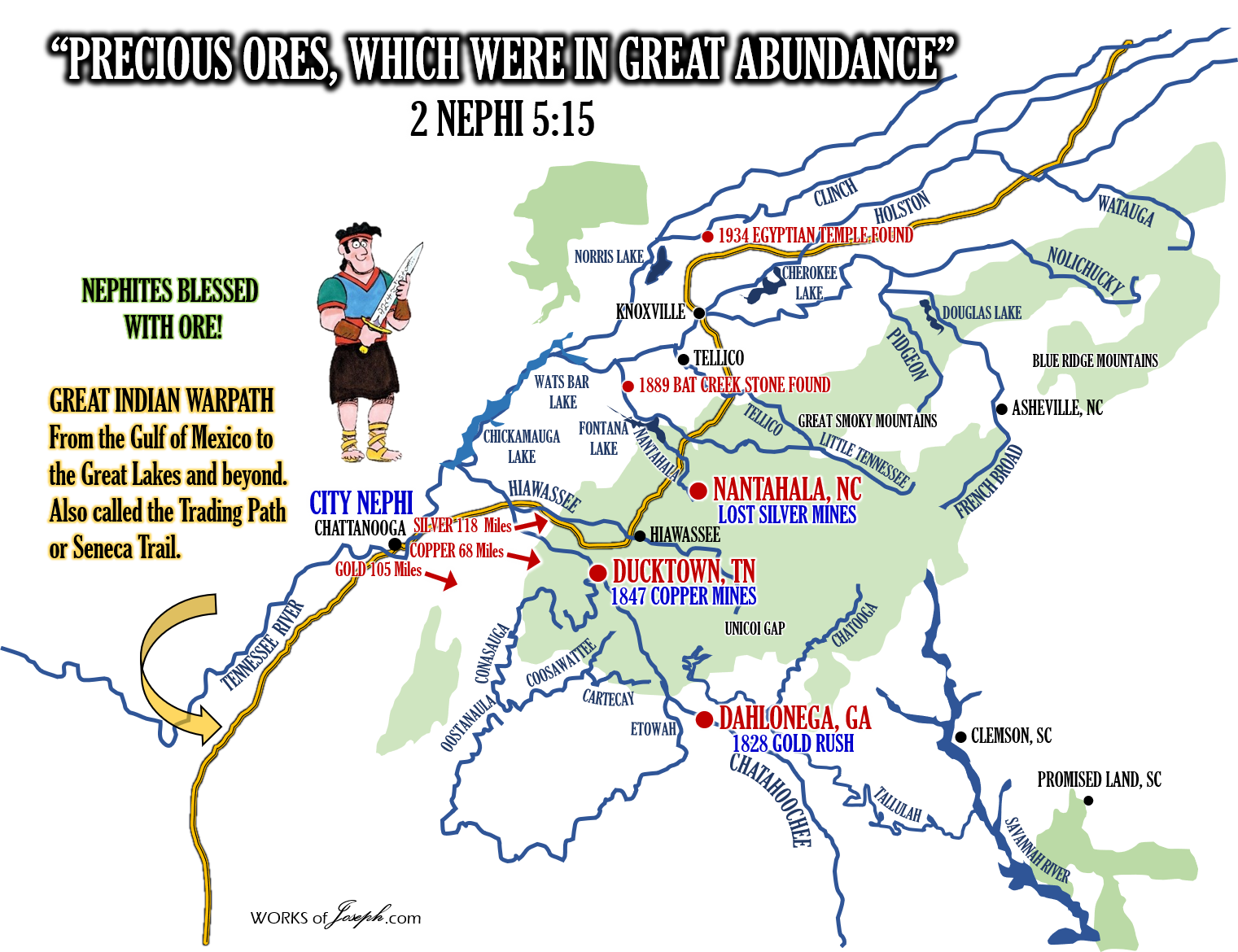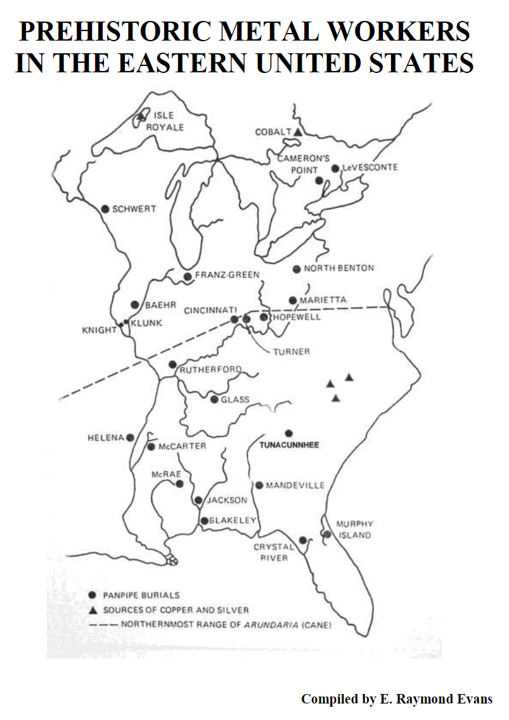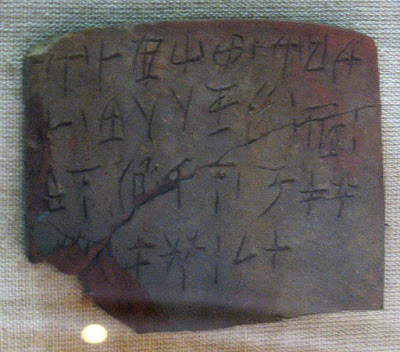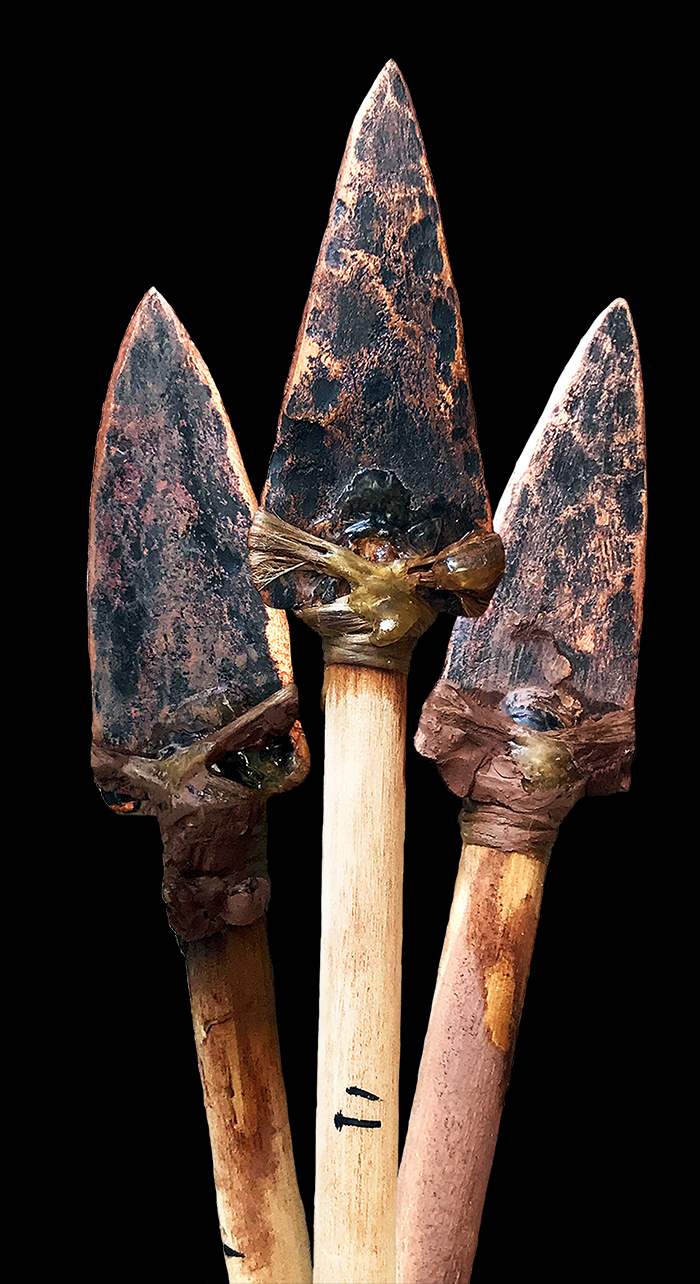Don’t let the title of this blog fool you. We discuss the ample evidence of copper in North America, and we discuss the possibility of finding Nephi’s steel bow in Jerusalem. Is it possible to also find a steel bow in North America? yes! The Lord provided copper, and many other ores to assist the Lehites near the Red Sea as well as helping the Nephites in Florida and Tennessee. See the map below of an abundance of copper, gold and silver found near Nephi in North America to make arrowheads, bows, breastplates and head plates.

You can also see in the map below, the abundance of copper and other ores in Michigan, the Land of Joseph in North America.

Jaredites and Nephites Utilized Copper and other Ores
“And they did work in all manner of ore, and they did make gold, and silver, and iron, and brass, and all manner of metals; and they did dig it out of the earth; wherefore, they did cast up mighty heaps of earth to get ore, of gold, and of silver, and of iron, and of copper. And they did work all manner of fine work. And they did have silks, and fine-twined linen; and they did work all manner of cloth, that they might clothe themselves from their nakedness. And they did make all manner of tools to till the earth, both to plow and to sow, to reap and to hoe, and also to thrash. And they did make all manner of tools with which they did work their beasts. And they did make all manner of weapons of war. And they did work all manner of work of exceedingly curious workmanship. And never could be a people more blessed than were they, and more prospered by the hand of the Lord. And they were in a land that was choice above all lands, for the Lord had spoken it. Ether 10:23-28
“And behold, also, they have brought breastplates, which are large, and they are of brass and of copper, and are perfectly sound. And again, they have brought swords, the hilts thereof have perished, and the blades thereof were cankered with rust…” Mosiah 8:10-11
“And we multiplied exceedingly, and spread upon the face of the land, and became exceedingly rich in gold, and in silver, and in precious things, and in fine workmanship of wood, in buildings, and in machinery, and also in iron and copper, and brass and steel, making all manner of tools of every kind to till the ground, and weapons of war—yea, the sharp pointed arrow, and the quiver, and the dart, and the javelin, and all preparations for war.” Jarom 1:8

SWORDS OF IRON, STEEL & COPPER IN NORTH AMERICA
“…they did cast up mighty heaps of earth to get ore of gold, and of silver, and of iron, and of copper.” (Ether 10:23)
If you are looking for the ores mentioned in the Book of Mormon, they do exist in abundance, and they have been found in North America. Many iron and copper swords HAVE been discovered. When most scientists or archaeologists find an unexplained item in their research, they very often label it a fake, or too good to be true. Since very few experts are looking in North America for iron and steel, it is ignored when they do find it. We will list many pictures and articles about iron and copper swords and other items found in North America in this article.

Father Edmund Bosley Mormon Pioneer
25 June 1776–15 Dec. 1846. He was a Miller. Born at Northumberland Co., Pennsylvania. Lived at Livonia, Livingston Co., New York, 1792–1834. Stockholder in Kirtland Safety Society. Served as second counselor in Kirtland elders quorum, 1837. Ordained a high priest, 1844, at Nauvoo, Hancock Co., Illinois.

“From the time Father Bosley* located near Avon [Livingston County, NY], he found and plowed up axes and irons, and had sufficient to make his mill irons, and had always abundance of iron on hand without purchasing. In the towns of Bloomfield, Victor, Manchester, and in the regions round about, there were hills upon the tops of which were entrenchments and fortifications, and in them were human bones, axes, tomahawks, points of arrows, beads and pipes, which were frequently found; and it was a common occurrence in the country to plow up axes, which I have done many times myself. “The hill Cumorah [the Jaredite hill Ramah] is a high hill for that country and had the appearance of a fortification or entrenchment around it. In the State of New York, probably there are hundreds of these fortifications which are now visible, and I have seen them in many other parts of the United States. “Readers of the Book of Mormon will remember that in this very region, according to that sacred record, the final battles were fought between the Nephites and Lamanites. At the hill Cumorah, the Nephites made their last stand prior to their utter extermination, A. D., 385.” – Life of Heber C. Kimball, by Orson F. Whitney, Salt Lake City, UT: Stevens & Wallis, Inc. [1888], 25. Quoted in Annotated Book of Mormon page 492 by David Hocking and Rod Meldrum Page 477
Nephi’s Steel Bow in North America?

“It seems to be a well-established fact that the bodies of nearly all those buried in mounds were partially, if not entirely, consumed by fire, before the mounds were built. This is made to appear by quantities of charcoal being found at the centre and base of the mounds—stones burned and blackened— and marks of fire on the metallic substances buried with them. It is a matter of much regret that on not one of the articles yet found have been discovered any letters, characters, or hieroglyphics, which would point to what nation or age these people belonged. We have been told by an eyewitness that a few years ago, near Blacksburgh, in Virginia, eighty miles from Marietta, there was found about half of a steel bow, which, when entire, would measure five or six feet; the other part was corroded or broken. The father of the man who found it was a blacksmith, and worked up this curious article, we suppose, with as little remorse as he would an old gun-barrel. Mounds are very frequent in that neighborhood, and many curious articles of antiquity have been found there. It is related from good authority that an ornament composed of very pure gold, something similar to those found in Marietta, was discovered a few years since in Ross county, Ohio, near Chillicothe, lying in the palm of a skeleton’s hand, in a small mound. This curiosity, it is stated, is in the museum at Philadelphia.” North America’s Indian Traditions, Archaeology & Book of Mormon II Ohio’s Ancient City edited by Wayne May Reprinted from The Wonders of the World, Boston, Massachusetts: The John Adams Lee Publishing Company, circa 1850.

I realize the steel bow spoken of above, could not have been Nephi’s bow. Of course Nephi’s steel bow was broken before the Lehites reached the Land of North America in about, 600–592 B.C. 1 Nephi 16:14-18 However, it shows steel bows are very likely found in both Jerusalem and North America.
 The Firm foundation is pleased to hear a presentation by Archaeologist, James Gee on Fri April 7, 2023 at 7 pm at the Mountain America Center at 9575 S. State St in Sandy Utah. See a video of Mr. Gee below, it’s fascinating. Tickets Here
The Firm foundation is pleased to hear a presentation by Archaeologist, James Gee on Fri April 7, 2023 at 7 pm at the Mountain America Center at 9575 S. State St in Sandy Utah. See a video of Mr. Gee below, it’s fascinating. Tickets Here
You can view here, the entire list of 75 speakers and the time they each speak, at our April 6-8 Conference.
Nephi’s Steel Bow Looked Like This! (Jim Gee) | Archaeological Evidence of the Book of Mormon
“A controversial topic amongst psuedoscientific anti-mormons is the existence or non-existence of Nephi’s steel bow. “Steel didn’t exist until we, the modern suburban and college-educated man invented it!” they can be heard crying from the rooftops of their failed academic institutions, clutching their dogmatic degrees harder than a catholic priest clutches the apocrypha in seminary. Enter Jim Gee to put their arrogant self-importance and so-called ‘knowledge’ out of its misery. Lol. That description was pretty epic… don’t you think?” Midnight Mormons
Who Mined Copper in Ancient America?
A very ancient copper ax found along Munch Creek in Pennsylvania baffled many archaeologists.
You see, according to them –
LINK: “I believe this ax was made by the Old Copper Culture of Upper Michigan. Noninvasive testing shows the purity of the copper is consistent with the Keweenaw Peninsula, which extends into Lake Superior.”
Native Americans could not “smelt” copper so it had to be layered and how they bonded the layers remains a question.[According to Wayne May they did smelt Copper]
It would appear the Adena people (yet to be explained highly unusual and sophisticated culture of the Ohio Valley region) traded with Upper Michigan for copper.
Academia tries to be very precise about their dealings with ancient finds because no one wants to hear from our teachers that they have no clue. So, they tell us the ancient Native People didn’t smelt. We kind of knew that already. But they can’t explain how they came across copper items. Now they have a conundrum they must explain.
Anyone in science who follows the basic concept of Okkam’s Razor knows, the least extraordinary explanation is the most logical, yet archaeologists and anthropologists try to push this away by saying, “well, there must have been Europeans who came over and did the smelting for them.”
Apparently ancient copper industry was outsourced. Hmm….
This is doubly insulting to the Native People, as they are basically saying, smart Europeans must have come over and done the important work for them and in the same breath are saying “let’s ignore their legends that tell about these white people with magical rocks that make mines sound with ringing. It’s not real source of information,” (even though they are the people of the area telling you what they witnessed and valued it enough to pass through oral culture).
To further verify what the natives of Wisconsin were saying, Spanish explorers going along the Gulf Coast in Texas came across the Karankawa Indians in the 1500s. They asked them, “dudes where did you get these copper items?” (okay, maybe not verbatim, but that was the gist of it). And the Native People said they traded with the people of the north for them. Those people from the north would be up the Mississippi in the Great Lakes mining region. Now, another tribe verifies trading copper with the mining northerns.
Let’s assume some crazy miners from (off the top of my head) Wales, came here way before Columbus and were mining thousands of years ago in Upper Michigan and in Wisconsin. They must have left their culture, right? Shouldn’t we be seeing their kinds of shelter, their kinds of writing on the rocks, their kind of tools? Hmmm…..
As well, it’s been found that Michigan copper is in the bronze of Europe long ago. So, someone was mining, smelting, and even shipping the copper, yet there is no evidence of Bronze Age European culture in the Great Lakes region. So, who were these “white people” who were mining using rather large tools?
The Newberry Tablet (photograph 1896) was found in the Michigan Great Lakes Area. Some say the script resembles ancient languages like Minoan. But, it if it doesn’t match it completely, it isn’t. The more likely assumption would be that, around the world there was an advanced culture that taught by example the concept of writing. Men of different regions cobbled a language from the forms they saw and so they often times resemble each others.

Crete Script/Newberry Tablet
The truly interesting thing is that this Crete script was likely based on the language imitated from the Original People of the world (some call them Atlantians, Ancient Giants, or Lumerians), and if people from Crete came and mined in America, they would have used their own language, yet the Newberry tablet does not exactly resemble their acquired language form.
So, what we can assume about the Newberry Tablet (by logical deduction) is that it was written by a culture as of yet not known. In other words, that Original Culture – that is their language unadulterated, not imitated by earlier man. The Crete tablet would be their own take on the concept of writing after looking at the Original Culture’s way of communicating with figures. This is why them seem vaguely similar.
If we want to understand the Original Culture, we need to decipher the Newberry Tablet. That’s their not-yet-imitated form of writing.

LINK: In the State of Michigan, the largest mine was on Isle Royale, an island in Lake Superior, near the Canadian border. Here, there are thousands of prehistoric copper pits, dug thousands of years ago by ancient peoples unknown. [Known to me as Jaredites]. The Minong Belt on Isle Royale has a distance of one and three quarter miles in length and is nearly four hundred feet wide. The copper pits range ten to thirty feet deep with connecting tunnels; one archaeologist estimated that their digging would take the equivalent of 10,000 men working for 1000 years. https://www.ghosthuntingtheories.com/2020/06/who-mined-copper-in-ancient-america.html
Ancient Native Americans were among the world’s first coppersmiths
By David Malakoff
About 8500 years ago, hunter-gatherers living beside Eagle Lake in Wisconsin hammered out a conical, 10-centimeter-long projectile point made of pure copper. The finely crafted point, used to hunt big game, highlights a New World technological triumph—and a puzzle. A new study of that artifact and other traces of prehistoric mining concludes that what is known as the Old Copper Culture emerged, then mysteriously faded, far earlier than once thought.
The dates show that early Native Americans were among the first people in the world to mine metal and fashion it into tools. [Jaredites?] They also suggest a regional climate shift might help explain why, after thousands of years, the pioneering metallurgists abruptly stopped making most copper tools and largely returned to stone and bone implements.
Purest Copper
Earth’s largest and purest copper deposits are found around North America’s Great Lakes. At some point, Native Americans learned to harvest the ore and heat, hammer, and grind it into tools. They left behind thousands of mines and countless copper artifacts, including lethal projectile points, hefty knives and axes, and petite fish hooks and awls. Today, it’s not uncommon to meet residents of the region “who have buckets of copper artifacts [that they’ve found] tucked away in their basements,” says David Pompeani, a geologist at Kansas State University, Manhattan, who studies ancient mining.
When researchers began to date the artifacts and mines, they saw a perplexing pattern: The dates suggested the people of the Old Copper Culture began to produce metal tools about 6000 years ago and then, for reasons that weren’t clear, mostly abandoned copper implements about 3000 years ago. After that, early Native Americans used copper mostly for smaller, less utilitarian items associated with adornment, such as beads and bracelets. “The history is just so peculiar,” in part because many other ancient cultures didn’t abandon metal tools once they learned how to make them, Pompeani says.
About 10 years ago, Pompeani began doctoral research that cast doubt on the Old Copper timeline. He extracted sediment cores from lakes adjacent to prehistoric mines on Michigan’s Keweenaw Peninsula and Isle Royale and measured trace metals in the cores, including lead and titanium, that had been released by processing the ore. The analyses showed copper mining began about 9500 years ago in some areas—some 3500 years earlier than once thought. It also ended earlier, about 5400 years ago, Pompeani reported in The Holocene in 2015.[I’m never swayed by specific dating times, as the dating process is full of holes].
Now, a team led by Pompeani presents new evidence for the revised timeline. The researchers used modern methods to reanalyze 53 radiocarbon dates—including eight newly collected dates—associated with the Old Copper Culture. Some came from wood or cordage still attached to spearpoints; others came from charcoal, wood, or bone found at mines and human burials. The oldest reliably dated artifact turned out to be the 8500-year-old projectile point found in Wisconsin.

This month in Radiocarbon, the team reports that the most reliable dates, combined with the sediment data, indicate the Old Copper Culture emerged at least 9500 years ago and peaked between 7000 and 5000 years ago.[Within a possible Adamite Culture or the Jaredites]. That makes it at least as old, and perhaps older, than copper-working cultures documented in the Middle East, where archaeologists have documented a copper pendant believed to be 8700 years old.
The older window for Old Copper’s peak doesn’t surprise archaeologist Michelle Bebber of Kent State University, Kent, who has studied the culture. The dates confirm “that hunter-gatherers [were] highly innovative,” she says, and willing to “regularly experiment with novel materials.”
But why did the ancient copper experiment abruptly end? Bebber’s work replicating Old Copper–style arrowheads, knives, and awls suggests they weren’t necessarily superior to the alternatives, especially after factoring in the time and effort required to produce metal implements. In controlled laboratory tests, such as shooting arrows into clay blocks that simulate meat, she found that stone and bone implements were mostly just as effective as copper. That might be because Great Lakes copper is unusually pure, which makes it soft, unlike harder natural copper alloys found elsewhere in the world, she says. Only copper awls proved superior to bone hole punchers.
Pompeani has identified another potential contributor to Old Copper’s fade about 5000 years ago. Sediment cores, tree ring data, and other evidence suggest a sustained dry period struck the region around that time, he says. That could have fueled social and ecological disruptions that made it hard to devote time and resources to making copper tools. Over time, copper may have become something of a luxury item, used to signal social status.[It may have had to do with the many battles and wars that could have uprooted the various cultures].
Copper awls, however, bucked this trend: They required relatively little ore to make, Bebber notes, and the people of the Great Lakes continued to use them for thousands of years. Posted in: Archaeology





